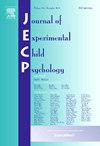婴儿的单眼间隙立体视。
IF 1.8
2区 心理学
Q3 PSYCHOLOGY, DEVELOPMENTAL
引用次数: 0
摘要
在单眼间隙立体视中,一只眼睛看到的是一个完整的矩形表面,而另一只眼睛看到的是两个相邻的小矩形表面,两者之间有一个狭窄的垂直间隙。我们的视觉系统将不匹配的单眼图像造成的差异解释为两个小矩形之间的深度差异。在一项自发视觉偏好研究中,我们询问了 4 个月大的参与者是否会对单眼间隙产生的深度效应做出反应。研究采用了两种实验条件。根据 Pianta 和 Gillam 对成人参与者进行的实验研究(2003 年,《视觉研究》,第 43 卷,第 1937-1950 页),在其中一个实验条件(大外缘差距条件)下,单眼深度效应是另一个实验条件(小外缘差距条件)下的两倍。在这两种条件下,都测试了带有单眼间隙立体感的刺激物是否比没有深度的对比刺激物更受青睐。结果表明,在大外缘差距条件下,被试更喜欢看带有单眼立体视的刺激物,而在小外缘差距条件下则不然。此外,实验条件之间的差异也很显著;也就是说,在外缘差距大的条件下,婴儿比在外缘差距小的条件下表现出更强的自发偏好。这些发现提供了证据,表明 4 个月大的婴儿能够对单眼垂直差距信息做出反应。本文章由计算机程序翻译,如有差异,请以英文原文为准。
Monocular gap stereopsis in infants
In monocular gap stereopsis, one eye perceives a complete rectangular surface while the other eye perceives two small adjacent rectangular surfaces separated by a narrow vertical gap. Our visual system interprets the difference caused by the unmatched monocular images as a depth difference between two small rectangles. In a spontaneous visual preference study, it was asked whether participants aged 4 months responded to the depth effect generated by a monocular gap. Two experimental conditions were conducted. In one (large outer edge disparity condition), the monocular depth effect was twice as strong as in the other one (small outer edge disparity condition), according to the experimental research with adult participants conducted by Pianta and Gillam (2003, Vision Research, Vol. 43, pp. 1937–1950). In both conditions, it was tested whether the stimulus bearing monocular gap stereopsis was preferred over a comparison stimulus without depth. According to the results, the participants preferred looking at the stimulus with monocular stereopsis in the large outer edge disparity condition over doing so in the small outer edge disparity condition. Moreover, the difference between experimental conditions was significant; that is, the infants displayed a stronger spontaneous preference in the condition with the large outer edge disparity than in the condition with the small outer edge disparity. These findings provide evidence to suggest that infants aged 4 months are able to respond to monocular vertical gap information.
求助全文
通过发布文献求助,成功后即可免费获取论文全文。
去求助
来源期刊

Journal of Experimental Child Psychology
Multiple-
CiteScore
4.50
自引率
7.70%
发文量
190
期刊介绍:
The Journal of Experimental Child Psychology is an excellent source of information concerning all aspects of the development of children. It includes empirical psychological research on cognitive, social/emotional, and physical development. In addition, the journal periodically publishes Special Topic issues.
 求助内容:
求助内容: 应助结果提醒方式:
应助结果提醒方式:


